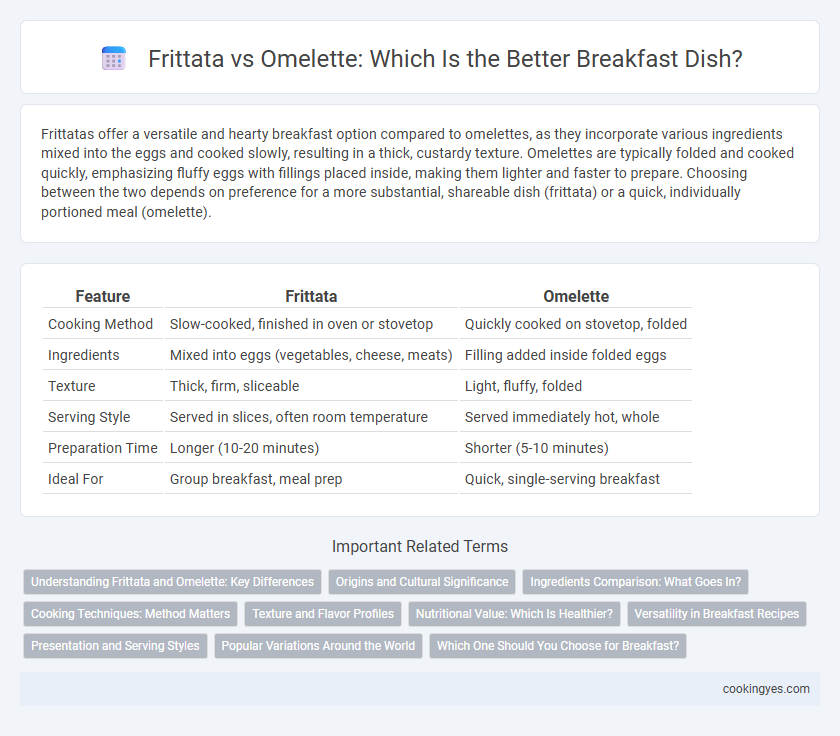Frittatas offer a versatile and hearty breakfast option compared to omelettes, as they incorporate various ingredients mixed into the eggs and cooked slowly, resulting in a thick, custardy texture. Omelettes are typically folded and cooked quickly, emphasizing fluffy eggs with fillings placed inside, making them lighter and faster to prepare. Choosing between the two depends on preference for a more substantial, shareable dish (frittata) or a quick, individually portioned meal (omelette).
Table of Comparison
| Feature | Frittata | Omelette |
|---|---|---|
| Cooking Method | Slow-cooked, finished in oven or stovetop | Quickly cooked on stovetop, folded |
| Ingredients | Mixed into eggs (vegetables, cheese, meats) | Filling added inside folded eggs |
| Texture | Thick, firm, sliceable | Light, fluffy, folded |
| Serving Style | Served in slices, often room temperature | Served immediately hot, whole |
| Preparation Time | Longer (10-20 minutes) | Shorter (5-10 minutes) |
| Ideal For | Group breakfast, meal prep | Quick, single-serving breakfast |
Understanding Frittata and Omelette: Key Differences
Frittatas are thicker, open-faced Italian egg dishes baked or finished in the oven, incorporating ingredients like vegetables, cheese, and meats evenly mixed into the eggs. Omelettes are thinner, folded eggs cooked quickly on the stovetop with fillings placed on one side before folding, resulting in a soft, fluffy texture. While both serve as versatile breakfast options, the frittata's baking process creates a denser, heartier dish compared to the lighter, more delicate omelette.
Origins and Cultural Significance
Frittatas originate from Italian cuisine, traditionally baked and featuring a mix of vegetables, cheeses, and meats, encapsulating Mediterranean flavors and heritage. Omelettes, rooted in French culinary tradition, are quickly cooked on stovetops and folded, symbolizing versatility and simplicity in European breakfast culture. Both dishes highlight diverse regional ingredients and cooking techniques, reflecting their distinct cultural significance in breakfast cuisine worldwide.
Ingredients Comparison: What Goes In?
Frittatas typically include a diverse mix of ingredients such as vegetables, cheeses, meats, and herbs, all combined and cooked slowly to create a thick, hearty dish. Omelettes usually contain fewer fillings, often limited to cheese, ham, mushrooms, or spinach, folded within a fluffy egg base. The key difference lies in the integration of ingredients: frittatas incorporate fillings throughout the eggs, while omelettes separate the fillings inside a folded egg.
Cooking Techniques: Method Matters
Frittatas require slow, even cooking in a skillet, often finished in the oven to ensure a fully set interior, while omelettes are quickly cooked over higher heat and folded before serving. The gentle, prolonged heat of a frittata allows for the incorporation of various ingredients evenly throughout the dish, contrasting with the omelette's rapid cooking that emphasizes a soft, tender texture. Understanding these distinct cooking techniques helps optimize flavor, texture, and presentation in breakfast dishes.
Texture and Flavor Profiles
Frittatas offer a dense, custardy texture with a rich, layered flavor profile due to the slow cooking and incorporation of multiple ingredients like vegetables, cheese, and meats. Omelettes present a lighter, fluffier texture with a more pronounced egg flavor, often highlighting simpler fillings that are folded inside. The choice between frittata and omelette impacts the overall breakfast experience, balancing heartiness against delicacy in mouthfeel and complexity in taste.
Nutritional Value: Which Is Healthier?
Frittatas offer a higher nutritional value than omelettes due to the inclusion of more vegetables and cheese, which boosts fiber, vitamins, and minerals. In contrast, omelettes typically contain fewer ingredients, leading to a lower calorie and fat content but less overall nutrient density. Choosing a frittata with vegetables and lean proteins maximizes vitamins A, C, and calcium while providing sustained energy throughout the morning.
Versatility in Breakfast Recipes
Frittatas offer greater versatility than omelettes due to their baked preparation, allowing for a wide variety of ingredients such as vegetables, meats, and cheeses to be evenly incorporated and cooked throughout. Unlike omelettes, which require folding and are typically served immediately, frittatas can be made ahead and served hot or cold, making them ideal for meal prep and large gatherings. This adaptability in texture and ingredient combinations makes frittatas a preferred choice in diverse breakfast recipes.
Presentation and Serving Styles
Frittatas offer a visually appealing, open-faced presentation suitable for slicing into wedges, making them ideal for communal breakfasts or buffet-style serving. Omelettes, typically folded and plated individually, emphasize a more personalized, elegant presentation for single servings. The frittata's thicker, baked texture allows for diverse toppings and garnishes that maintain shape during serving, contrasting with the omelette's delicate, softer finish.
Popular Variations Around the World
Frittatas are known for their thick, crustless texture and versatility, often baked or finished in the oven, contrasting with the quick-cooked, folded omelette. Popular variations include the Italian Frittata di Verdure, loaded with seasonal vegetables, and the Spanish Tortilla Espanola, which features potatoes and onions as key ingredients. Around the world, these dishes showcase regional flavors, with frittatas favoring a heartier, open-faced presentation while omelettes emphasize a soft, folded form often filled with cheese, herbs, or meats.
Which One Should You Choose for Breakfast?
Frittatas offer a thicker, more versatile breakfast option by incorporating a variety of ingredients mixed directly into the egg base, providing a nutrient-dense meal. Omelettes, known for their quick cooking time and folded presentation, are ideal for a lighter, protein-rich breakfast. Choosing between a frittata and an omelette depends on desired portion size and ingredient flexibility for a satisfying morning dish.
Frittata vs Omelette for Breakfast Dishes Infographic

 cookingyes.com
cookingyes.com